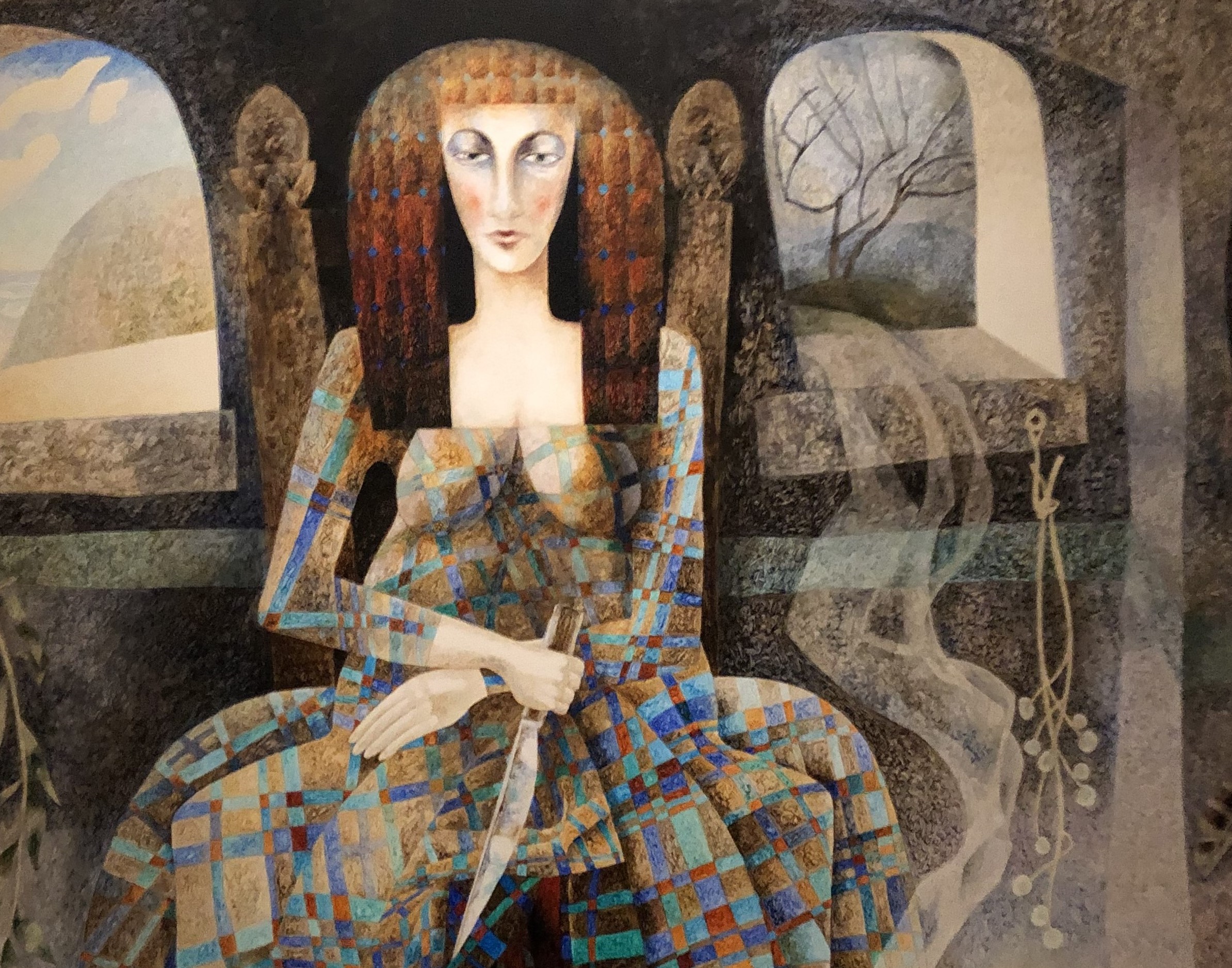
Christopher Williams is little known today outside his home town of Maesteg, but in his heyday – he was born in 1873 and died in 1934 – he was regarded as the outstanding painter of Wales. He earned his living mainly by painting portraits. Among his subjects were many of the Welsh public figures of the day, like Lloyd George, Sir John Morris Jones and Sir John Rhys. But he was trained to paint in the old academic tradition of the Royal College of Art and the Academy Schools, which at the time prized the production of large canvases based on mythological and historical themes.
Williams, who was devoted to Wales throughout his life, developed the ambition of adapting this rather moth-eaten tradition to serve Welsh themes. Influenced by the allegorical paintings of George Frederic Watts, he started work on what became a triptych of major works based on women from medieval Welsh poetry and the Mabinogi, sources which he described as ‘a gold mine untouched and full of Welsh fire and imagination’. Branwen was the second in 1915, and Blodeuwedd came third in 1925-30, but William’s first choice was Ceridwen. He completed the painting of that name in 1910. It’s now in the Glynn Vivian Art Gallery, where it seldom sees the light of day.

Ceridwen was a curious choice, though she wasn’t entirely unknown. Williams may have been aware of her from several sources, including Thomas Love Peacock’s poem ‘The cauldron of Ceridwen’. She’s a mysterious figure, first glimpsed in poems included in the fourteenth century Llyfr Taliesin, sometimes as the guardian of a cauldron. The cauldron is filled with awen, or inspiration, so that Ceridwen appears as a muse or source of poetic inspiration.

In the sixteenth century, in a manuscript written by the chronicler Elis Gruffydd, a story, ‘Hanes Taliesin’, gathers around her. To endow her son with wisdom, in compensation for his ugly appearance, she mixes a potion for him. The first three drops will do the trick, though the rest of the liquid is poison. However, after she falls asleep, Gwion Bach, the young lad stoking the fire beneath the cauldron, accidentally tastes the three drops that have escaped from it. Immediately he, and not Ceridwen’s son, becomes the all-wise one. The cauldron splits in two. Gwion flees, pursued by the angry Ceridwen. Both change their shapes, into successive pairs of prey and predator – hare/greyhound, fish/otter, bird/hawk, hen/grain of corn, before Ceridwen finally eats Gwion, later giving birth to the poet Taliesin.

In his picture Williams ignores the shapeshifting and concentrates his attention on Ceridwen and the cauldron. Sitting in a mountainous and remote setting, Ceridwen is a commanding presence. She’s bare-shouldered and déshabillé, and wears a rich red dress that wouldn’t be out of place in a fashionable Edwardian salon. Feet bare, legs crossed, elbow on knee, hand on cheek, she stares straight out at us, under a mass of black hair. Her face, by the way, looks rather androgenous, much like the face of Gwenllian in Williams’s huge allegory of 1912, Wales awakening. Her expression is certainly grim: she’s smouldering with rage and in a moment, you feel, she’ll explode into retaliatory action. It takes a while to realise that the strange shape to her left is the broken cauldron, with the poison running out of it.
Did Christopher Williams really expect those who looked at his painting to be aware of the stories surrounding Ceridwen and her cauldron? Was it enough that they could understand that she was a symbol of inspiration and creativity, ideas that Williams valued highly and wished to see pursued by his contemporaries? Or was he content that Ceridwen appeared simply as a dark figure of the Celtic past, her obscurity just part of her mysterious allure?
Williams exhibited Ceridwen, but never sold her – the same was true of the others in the Welsh mythological series – and he left the painting to the Glynn Vivian on his death.

Last week, I was surprised to see another, more recent painting of Ceridwen, displayed as part of an exhibition in Y Gaer, Brecon to celebrate twenty-five years of collecting by the Brecknock Art Trust. It’s by the Crickhowell artist Tim Rossiter, and forms part of a large project, ‘Ceridwen and Gwion’ made in collaboration with a number of poets between 2009 and 2012.
The picture, entitled Ceridwen and Gwion Bach, no.8, shows Ceridwen seated, this time indoors, with a fashionably contemporary full-length dress, and with a very direct and determined gaze. In other respects Rossiter departs from Williams’s portrait. This Ceridwen is stylised rather than naturalistic. Her hair resembles that of an archaic Greek korē. Her skin is all-white, except for her cheeks, red with embarrassment, and she holds a murderously long knife. Revenge is at hand.
At Ceridwen’s feet is the cauldron – plants and other ingredients of the potion are arranged on either side of her – and already steam from the potion is escaping through the open window to poison the waters outside.
If you’re aware of the story and you look at both pictures long enough, you realise that you’re standing in the place of Gwion Bach. It’s you that Ceridwen has her sights on. Her grim face (and sharp knife, in Rossiter’s case) threaten you, and it’s time to flee. Poor Gwion, thanks to the three drops, he’s wise enough to be able to foresee his terrible fate, and all the magical transformations in the world won’t save him from being eaten by Ceridwen.
If you do decide to flee, by the way, other Ceridwens are available. Angharad Tomos’s classic Rala Rwdins picture books for children feature a wise and kindly witch of that name, and Seren Morgan Jones’s more recent Ceridwen, though she has a penetrating frontal gaze, is mercifully free of deadly weaponry.


Leave a Reply